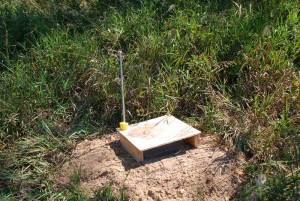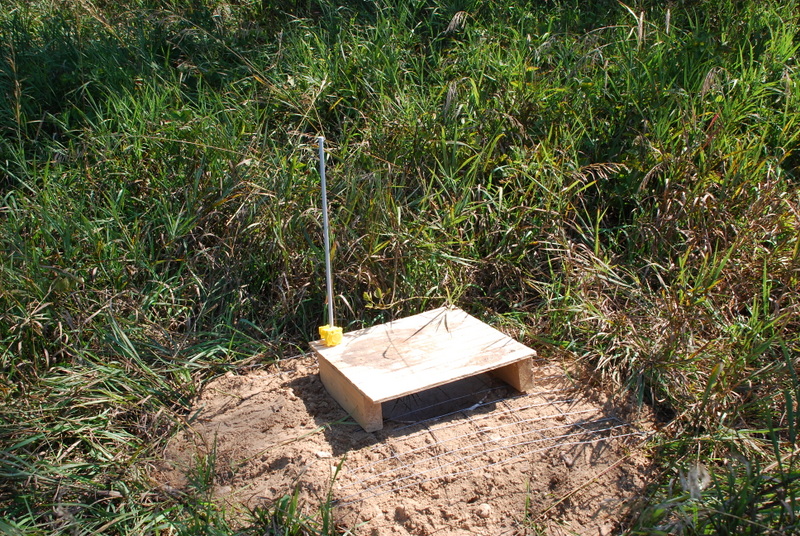By Zachary Peña

A pitfall trap used by David Cuthrell to capture burying beetles for study by the Michigan Natural Features Inventory. Photo: David Cuthrell
Ohio scientists are using small, dead animals to trap an endangered insect in hopes of reintroducing significant colonies into Ohio forests.
North of those forests, Michigan scientists are unsuccessfully seeking out the same bug.
The Ohio Department of Natural Resources, Ohio State University and other organizations have assisted in restoring the number of American burying beetles in captivity. They have been distributing the insect throughout The Ohio Wilds Conservation Center and Wayne National Forest in Ohio since 2003.
This summer, the Michigan Natural Features Inventory, a team of scientists who collect information about Michigan’s native plants, animals, aquatic animals and natural ecosystems, searched Michigan forests in vain for the beetle, despite trapping hundreds of burying beetles of the same genus, said entomologist David Cuthrell.
“This is all good information, as I am as interested in the distribution and status of the other beetles as well,” Cuthrell said.
Meanwhile the Ohio effort to restore these carrion specialists continues.
“Next year we’ll do another release at The Wilds,” said George Keeney, an Ohio State University researcher. “This year and the four prior years, we did releases at

Cuthrell’s captured beetles in a bucket. Although the beetles belong to the burying beetle genus, none belong to the American burying beetle species. Photo: David Cuthrell
the Wayne National Forest.”
Such work is important, Cuthrell said.
“Not only is it important to mitigate their losses due to development, I think it is important to re-introduce them into areas of the country that will give the beetles the best chance to respond to any future issues whether it be global climate change, insect diseases.”
The beetles need a carcass the size of a dove or chipmunk to raise their young, according to the Ohio Department of Natural Resources. They are among the few insects where both the males and females raise their young.
The insect is prized for its ability to restore nutrients to the soil. Why it has become endangered is a mystery to entomologists.
“Several hypotheses have been formulated,” Cuthrell said. Among them are the loss of the right-sized food, increasing populations of other scavengers, loss of habitat and insect diseases.
The Ohio Department of Natural Resources released close to 3,000 beetles across Ohio during the past nine years. The most recent 171 of those were released in June 2011.
Restoration efforts are ongoing, said Carolyn Caldwell of The Ohio Department of Natural Resources’ Division of Wildlife. From 2002-2012, Ohio State University, the St. Louis Zoo, and The Wilds have produced than 3000 adult beetles.
These large, captive beetle colonies begin with a few insects acquired in various traps.
Keeney said the traps he uses involve pits lightly covered with leaves and rotten chicken pieces as bait.
“We also put a piece of poultry netting held down by two gutter spikes to discourage scavengers,” Keeney said. “Then we come back the next morning to see if anything was caught.”

Another collection of beetles captured by Cuthrell. Again, these beetles belong to the burying beetle genus, but none belong to the American burying beetle species. Photo: David Cuthrell
The beetle reproduces slowly which is why the Ohio project has been ongoing for ten years, Keeney said. A normal number of offspring runs anywhere from the low teens to low twenties.
The last American burying beetle reported in Ohio was in 1974, according to the Ohio Department of Natural Resources’ website. It was listed as a state and federally endangered species in 1989.
The American burying beetle can only be found today in the wild in Arkansas, Kansas, Nebraska, Oklahoma, South Dakota, and on a small island off the coast of Rhode Island, the agency reports. A successful reintroduction has returned the beetle to two Massachusetts islands: Penikese and Nantucket.
